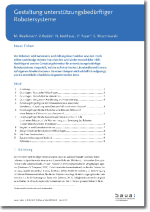- Project number: F 2434
- Institution: Federal Institute for Occupational Safety and Health (BAuA)
- Status: Completed Project
Description:
Service and assistance robots already have various useful capabilities and are used, for example, in industrial production or within the care sector. Nevertheless, at least for subtasks, they will continue to depend on human support. This also applies in terms of door opening and elevator use - both important abilities for a flexible and mobile use of the robot. The project addressed this problem by way of human assistance: The robots ask humans for help. This leads to various questions regarding the design and impact of human-robot interaction on work processes.
A major objective of this project was the development of concepts that contribute to a productive, safe and humane interaction between human and robot. In particular, the design of the interaction process's central components in the context of the request for help was considered. The research focused on the used dialogues, as from a human-centred perspective the structure of the help request is of great importance for the potential supporter's motivation to provide help as well as for interaction quality. Therefore, the dialogue concepts were designed to ensure that potential supporters are addressed appropriately and enabled to interact with the robot in an effective and efficient way. Aspects of initiating interactions, for example recognition and approach, which are closely connected to the dialogue design, were also taken into account. In order to ensure the suitability of the developed concepts, various surveys and investigations with potential users were carried out, both in a laboratory environment as well as in the production context. Based on these results, the systems’ functionality was continuously adjusted.
The interaction concepts developed rest on simple and understandable verbal and non-verbal communication mechanisms, enabling transferability to any scenario with heterogeneous user groups. Thus, a broad application can be realised in practice.
